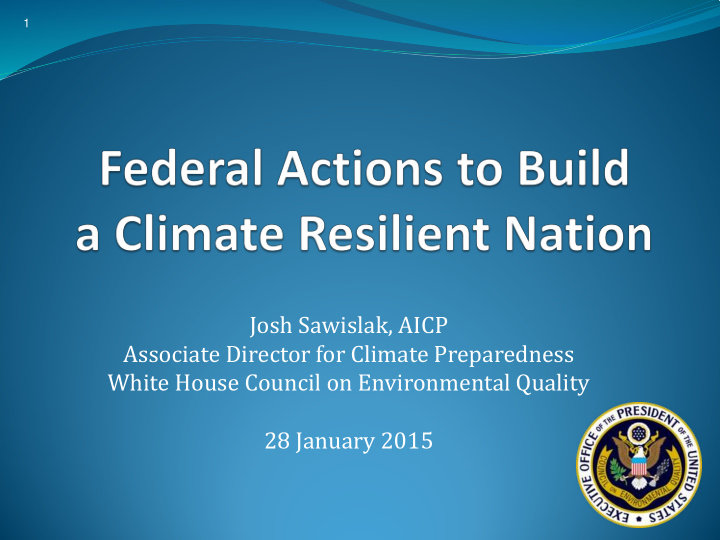



1 Josh Sawislak, AICP Associate Director for Climate Preparedness White House Council on Environmental Quality 28 January 2015
2 Overview What does it mean to adapt to climate change? What do decision-makers need? How is the Federal Government responding?
3 The climate is changing • In the United States, greenhouse gas emissions caused by human activities increased by 14 percent from 1990 to 2008 • Average temperatures have risen across the lower 48 states since 1901 to 2010, with an increased rate of warming over the past 30 years • Seven of the top 10 warmest years on record for the lower 48 states have occurred since 1990, and the last 10 five-year periods have been the warmest five-year periods on record • 2014 was the warmest year ever recorded
4 The Need to Adapt • More variable weather patterns • Extreme heat • Intense storms • Flooding • Drought • Social and economic concerns
5 What does it mean to adapt to climate change? Responsible risk management Actions that reduce vulnerability & enhance preparedness for climate & extreme weather- related impacts Coastal erosion from sea-level rise. Common-sense planning to Cedar Island, VA protect our health, safety & prosperity
6 What is the Federal role in adapting to climate change? Provide climate science & services to help communities make better decisions that reduce risks to people & property Potential inundation of Charleston, SC Manage climate risks to with 0.5 meter of sea level rise. Federal services, operations & assets
7 How is the Federal Government adapting to climate change? Executive Order 13653 – Preparing the United States for the Impacts of Climate Change Interagency Climate Change Council Active engagement of over 20 Federal organizations Working with state, local, and tribal officials to provide data, tools, expertise, and cut red tape Implementing recommendations to minimize climate risks Coordination, exchange of best-practices Reporting on progress Agency Adaptation Plans
8 Principles to Guide Adaptation Integrate into ongoing planning Prioritize Best-Available Science Strong Partnerships Risk-Management Ecosystem Services Multiple Benefits Evaluate Performance
9 Disaster Preparedness & Infrastructure Improve disaster preparedness & recovery Protect critical infrastructure Reduce risks to highways, railways and ports of flooding & damage from more intense storms
10 Healthy & Safe Communities Monitor & reduce climate risks to public health, including severe heat & diseases Reduce flooding & storm- surge risks to property & people Lower risks of sewage overflow from severe storms Overflowing sewer in Roswell, GA
11 Coastal Communities & Ecosystems Prepare for the threats of rising sea levels increased storm surge groundwater salinization coral bleaching Storm surge on a Louisiana highway ocean acidification
National Climate Assessment Third NCA released in 2014 Data and projections by region Much of the data has been downscaled to help local communities 12
Climate Data and Toolkit http://toolkit.climate.gov 13
Engaging the Private Sector Build America Investment Initiative Water Infrastructure and Resiliency Finance Center White House Insurance and Re-Insurance Discussions 14
The Time to Act is Now “And no challenge -- no challenge -- poses a greater threat to future generations than climate change. 2014 was the planet's warmest year on record. Now, one year doesn't make a trend, but this does -- 14 of the 15 warmest years on record have all fallen in the first 15 years of this century.” President Obama 2015 State of the Union 15
GoToWebinar Housekeeping: time for questions Your Participation • Please continue to submit your text questions and comments using the Questions Panel.
For more information: Jason Liechty Environmental Projects Coordinator Environmental Planning and Community Resilience Division Broward County 954-519-0310 jliechty@broward.org Today’s webinar will be posted to the Compact’s website soon: www.southeastfloridaclimatecompact.org
Recommend
More recommend